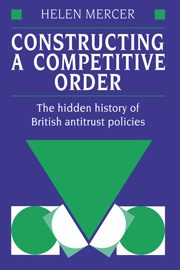Book contents
- Frontmatter
- Contents
- List of tables
- Acknowledgements
- Notes on conventions and abbreviations
- 1 Introduction
- 2 The British cartel system, 1880–1964
- 3 The state and the ‘monopoly problem’, 1880–1939
- 4 The war and the White Paper, 1940–44
- 5 The origins of the Monopolies and Restrictive Practices Act, 1948
- 6 Interpretation of policy – the Monopolies and Restrictive Practices Commission, 1949–56
- 7 The origins of the Restrictive Trade Practices Act 1956 – a re-interpretation
- 8 Resale price maintenance
- 9 Conclusions
- Appendixes
- Notes
- Bibliography
- Index
2 - The British cartel system, 1880–1964
Published online by Cambridge University Press: 29 January 2010
- Frontmatter
- Contents
- List of tables
- Acknowledgements
- Notes on conventions and abbreviations
- 1 Introduction
- 2 The British cartel system, 1880–1964
- 3 The state and the ‘monopoly problem’, 1880–1939
- 4 The war and the White Paper, 1940–44
- 5 The origins of the Monopolies and Restrictive Practices Act, 1948
- 6 Interpretation of policy – the Monopolies and Restrictive Practices Commission, 1949–56
- 7 The origins of the Restrictive Trade Practices Act 1956 – a re-interpretation
- 8 Resale price maintenance
- 9 Conclusions
- Appendixes
- Notes
- Bibliography
- Index
Summary
People of the same trade seldom meet together, even for merriment or diversion, but the conversation ends in a conspiracy against the Publick or in some contrivance to raise prices.
Adam Smith An enquiry into the Nature and Causes of the Wealth of Nations, 1776 edited by R.H. Campbell and A.S. Skinner (Oxford, 1976) I.x.c.27 p. 145.
Some definitions of cartels:
‘Planned Trading: the unwilling tribute paid by Capitalism to Socialism.’ ‘Social Security for Shareholders’.
Dalton Papers 7/6 unsigned memorandum by an official at the Board of Trade, 30/9/1944 giving Dalton definitions of a cartel in preparation for parliamentary questions.
Recent accounts of the historical evolution of the ‘corporate economy’ in Britain have focussed primarily on the development of the large firm. The history of cartels has received only cursory attention, although recently the significance of price-fixing in the 1930s has been re-assessed. Yet cartels, international and domestic, were arguably the dominant form of market control from the 1930s to the early 1950s, and together with a critical level of concentration of ownership and technical development created a culture of collusion. It was against this widespread cartelisation that the Acts of 1948 and 1956 were directed.
This chapter traces the interwoven development of cartels and concentration in British manufacturing from the 1880s to the 1950s. It looks at the development of the British trade association system before commenting briefly on some views of the causes and consequences of restrictionism in British manufacturing especially in the middle years of the twentieth century.
A cartel is a collusive strategy which, because the associated firms remain nominally independent, does not end the competition among them, ‘rather is the arena changed’.
- Type
- Chapter
- Information
- Constructing a Competitive OrderThe Hidden History of British Antitrust Policies, pp. 8 - 35Publisher: Cambridge University PressPrint publication year: 1995



